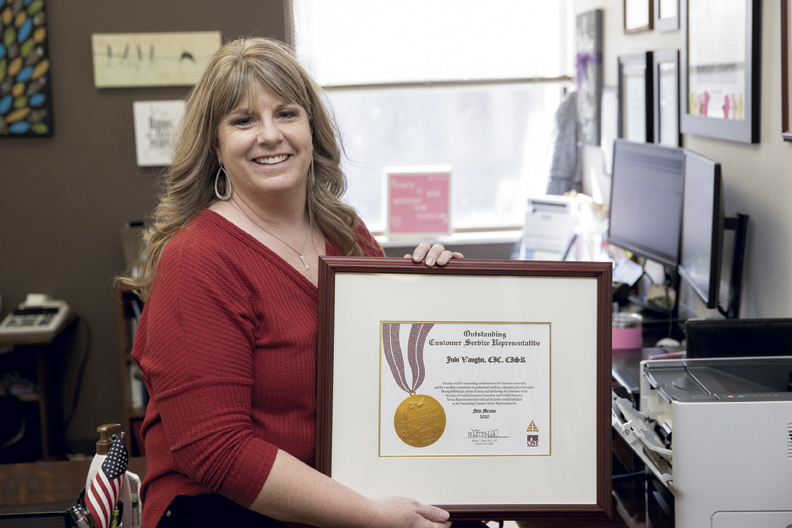Personal Lines Focus
2021 MARKET OUTLOOK
By Lori Widmer
While the personal lines market in 2020 can be defined by the word “pandemic,” the 2021 market may well be remembered with a different word: “digital.”
“Digital is huge,” says Mike Grove, senior product manager for Safeco Insurance. “There’s a significant uptick in customers submitting claims digitally. Our data indicates customers reporting claims digitally were up 126% year over year for our most recent month of results. And our data is showing that those who do so have better claim satisfaction than those who don’t.”

—Mike Grove
Senior Product Manager
Safeco Insurance
That’s a seismic change over just a few years, when Grove says the agent community was still reluctant to shift to a more virtual transaction model. Not that there wasn’t reason to balk at the idea: Many agents were concerned about missing out on the opportunity to cross-sell or conduct an account review during these interactions, which they believed were most effective in a one-on-one conversation.
Yet the challenges that emerged in 2020 served as a catalyst—and possibly a lesson—on why agents and brokers should be embracing a more digital presence for the benefit of their customers. Particularly with Millennial insurance buyers, Grove says, digital is in demand. “All they’ve ever known is the ability to go online, so agents need to capture that market. If a carrier or agency doesn’t adopt that strategy, they could be losing business today.”
It’s not just the Millennial market that is demanding more virtual shop-ping options, says Bob Sadler, senior vice president and head of independent agency operations for Farmers Insurance. “Stay-at-home orders and emergency restrictions have most likely affected consumer online shopping and buying behavior in a big way.”
It’s also affecting how agents conduct business, says Sadler. “We’ve been contacted by more and more independent agencies that are creating new interfaces for their customers from their websites. Interest in our API (Application Programming Interface) has risen substantially as agents realized during COVID that they needed to provide not only a customer service outlet but also a quote and new business portal.”
2020 market carryovers
Aside from the digital transformation, those same stay-at-home recommendations were responsible for plenty of market fluctuation in the personal lines arena earlier in the year, says Brian Botwinick, private client services practice leader for One80 Intermediaries. That brief slowdown, he says, was the result of agents transitioning to a remote work model. But business, he says, is back. “We have recently seen an exponential increase in submission flow.”
Much of the business, Botwinick says, is the result of a number of factors: “Individuals moving out of urban centers and thus driving the market in suburban and vacation areas, and increasing investments related to home construction and renovations. In my view, people will continue to move out of cities for the foreseeable future, and businesses will also reevaluate their need for office space, particularly in urban areas.”
The slowdown also can be attributed in part to price shopping. “Some recent independent agency surveys have revealed that price has risen to the top of the list of most important reasons for choosing a carrier,” says Sadler.

—Bob Sadler
Senior Vice President and
Head of Independent Agency Operations
Farmers Insurance
Yet he cautions agents and brokers about competing on price. “Customers tend to leave agencies in the same way they joined them, and customers who choose an agent on the basis of price are just as likely to leave for the same reason. Customers who are sold on the value of the policy, and especially on the value of the agency, are much more likely to remain loyal over time,” Sadler says.
Still, it’s a strategy that may not stand out in a crowd. And the personal lines market is crowded, says Grove. He’s seen increased local competition as companies focus on the Southeastern states and look to broaden their portfolios across other CAT-prone areas of the country. He’s also seen states that have experienced repeated significant losses becoming concerned that some carriers will not renew policies in high-risk areas, particularly in regions that saw wide-spread wildfire damage. How the industry employs wildfire mapping, and what regulatory changes may come from the repeated CAT losses, are where Grove sees changes emerging. “It’s an area that I think will see some tightening, and aside from California markets, maybe in Oregon and Colorado where folks are waking up to the potential.”
Yet where there is tightening, there is opportunity, and Grove says he’s seen new players trying to take up the slack. “There are a lot of startup, property-focused companies that are growing pretty fast and picking up some business in some of these areas where some national carriers might be operating a little more conservatively,” he says.
As CAT exposures continue, expect more localized changes, says Botwinick. He’s seen domestic carriers and Lloyd’s of London syndicates already restricting capacity in CAT-prone areas, such as coastal regions and areas with wildfire exposure. “Further, in the primary excess and surplus lines space we have seen drastic rate increases in CAT areas. In some cases there is no capacity available at any price, which is some-thing we have not experienced in other hard markets,” says Botwinick.
Regulatory changes
For lines that are not experiencing significantly higher losses, such as auto insurance, the market is facing an opposite issue—how to price for decreased need. “We continue to watch the impact of COVID on how state insurance departments view automobile rates,” says Sadler. “Auto claims are at or near pre-pandemic levels, and pre-pandemic rates were generally short of the need. Economic impacts from the virus have created new conversations about some underwriting and rating variables.”
That is evidenced by actions taken in a few states to reform current regulations. In Michigan, says Grove, the state’s personal injury protection (PIP) coverage underwent substantial reform in July 2020. The state’s new no-fault insurance legislation removed the unlimited coverage mandate that was contributing to Michigan having one of the highest average auto insurance premium levels in the country. These changes give consumers options to help with their premium costs while creating a great opportunity for agents to provide consultative guidance to help them choose the coverage that best suits their individual situation.

—Brian Botwinick
Private Client Services Practice Leader
One80 Intermediaries
The change, says Grove, gives consumers more choice in how much PIP they want to carry. It is coupled with guaranteed rate reductions for eight years. “Most carriers were fully supportive of giving customers choice,” says Grove. “Because unlimited PIP existed only in Michigan, it was expensive.”
Now, lower prices mean agents are seeing higher shopping rates, which create opportunities to capture new clients. It may also set a precedent that other states may follow, says Grove. He’s seen similar PIP changes in Florida and New Jersey, although not to the degree seen in Michigan. “What happened in Michigan was one of the biggest reforms at a state level that many of us will probably see in our career,” he adds.
In fact, the personal auto line is seeing more regulatory focus right now, most likely because of pandemic-related declines in driving and travel. “Some departments of insurance are getting more restrictive, focusing more scrutiny on variables that are used in company rating plans,” says Grove.
Into 2021
Still, COVID-19 cannot be to blame for all the changes in the market. Sadler believes what will be carried into 2021 will be CAT activity. “Given the extraordinary claim events associated not only with the virus, but also with wildfire and hurricane activity, I think we’re all looking at 2021 and beyond with some questions about not only primary capacity, but also reinsurer rates and appetite. We don’t have any signals yet in this space, but it seems reasonable that adjustments might be made by the reinsurance community.”
There is also demand for new products and more attractive variations of existing coverage. For the high-net-worth sector, Botwinick sees a number of new entrants, which increases the options consumers will have going forward. New products and services are dominating the market, as well. “Products available include personal cyber, service line coverage, equipment breakdown, home and family protection,” Botwinick says. “Services available include hurricane and wildfire loss control projects, background checks, and referrals to loss control or loss mitigation specialists.”
Another hot area: the private flood market. “Private flood insurance has become a significant part of our business,” Botwinick says. “Many agents and customers seek this coverage in the private market for ease of doing business. Additionally, many require limits higher than $250,000 building and $100,000 contents, the maximum available through the National Flood Insurance Program (NFIP).”
The private flood market has responded, he says. Quoting, binding and issuing are done through a simplified process, and higher limits and more sophisticated pricing make the product a more attractive option for buyers.
Another add-on: personal cyber protection. Botwinick is seeing high-net-worth carriers including it in homeowners policies or offering it as an optional endorsement. “We have also seen new products specifically for home sharing, ride sharing, and consumer products such as bicycles and electronics,” he says.
Advice for agents and brokers
New items or improvements are loss exposures that too many homeowners overlook, says Grove. He recommends that agents probe here when interacting with a client. Policyholders, he says, “have been upgrading their basements or doing home renovations.”
That’s a golden opportunity for agents to serve their customers. “It’s a good time for agents to add value by asking questions. ‘Have you made any changes to your house? Have you added a home gym?’ Probe for these exposures” and show the value the agency can bring to the policyholder, Grove says.
“It’s a good time for agents to add value by asking questions. ‘Have you made any changes to your house? Have you added a home gym?’ Probe for these exposures.”
—Mike Grove
Botwinick says that kind of proactive conversation can do plenty to improve loss prevention. “Many carriers have made significant investments so they can offer loss control advice, preventive tips and loss control services. I recommend using these valuable services. While the purpose of insurance is to pay for claims, to me the cost of implementing some simple loss control measures outweighs the potential aggravation of dealing with a claim and potentially being temporarily displaced from your home.”
Agents also may want to explore digital business models. “Agents should investigate their customer-facing capabilities, including 24/7 quoting, buying and policy servicing at their own websites and also should explore broader digital communication with both customers and prospects,” says Sadler.
Grove recommends talking with carriers to see what resources are available to make the transition go more smoothly. “If I were an agent, I would ask, ‘Am I prepared?’ As a carrier, we want to provide the tools and capabilities that allow an agent to succeed in the changing world,” he says.
Though digital conversion is critical, it needs a more personal touch. Going forward, agents and brokers should rely more on developing relationships with policyholders than on promoting price as the differentiator. “Brokers and agents should take a more consultative approach when working with new clients,” says Botwinick. “Through initial conversations with prospects to understand their individual needs and exposures, the producer can then identify carriers that will provide appropriate protection for the insured’s assets.”
For more information:
Farmers Insurance
www.farmers.com
One80 Intermediaries
www.one80intermediaries.com
Safeco Insurance
www.safeco.com
The author
Lori Widmer is a Philadelphia-based writer and editor who specializes in insurance and risk management.






